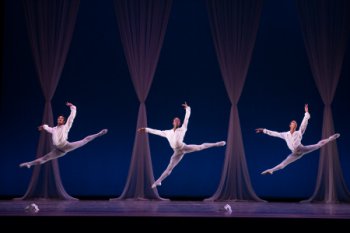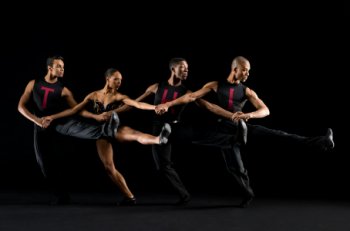Dance Theatre of Harlem 2016
Arthur Mitchell’s ballet company lives on.

Dylan Santos, Da’Von Doane and Francis Lawrence in a scene from Elena Kunikova’s “Divertimento” (Photo credit: Rachel Neville)
[avatar user=”Joel Benjamin” size=”96″ align=”left” ] Joel Benjamin, Critic[/avatar]The Dance Theatre of Harlem was founded as a political and artistic statement in response to the turmoil of the late sixties in which major leaders in the fight for racial equality, including Dr. Martin Luther King, Jr. and Malcolm X, were assassinated. New York City Ballet star Arthur Mitchell gathered his forces and created a vibrant, mostly black, ballet troupe which subsequently experienced many ups and downs.
The DTH produced some audacious dancers and made it clear that dancers of all ethnicities could dance the classics of ballet and modern dance with aplomb. It was a courageous experiment that opened doors that eventually would lead to the total acceptance of ballerinas like Misty Copeland, the first black principal dancer in a major ballet troupe, American Ballet Theatre.
It is terrific that the DTH has been given new life over the past few years under the direction of ballerina-emerita, Virginia Johnson. The recent (too short) season at the New York City Center displayed a ballet troupe still struggling hard to develop a distinct personality.
The four works on the Dance Theatre of Harlem’s program revealed a troupe that loves to entertain and show off but one that also hasn’t quite reached a secure level of technical achievement. Fervor and personality can take a dance company only so far. Nevertheless, this is definitely a ballet company with most works featuring solid point work.
The first work, with the pallid title “Divertimento” was choreographed by the Russian ballerina/teacher Elena Kunikova to an equally undistinguished bit of chamber music by Glinka. She put her three couples through clichéd ballet moves that rarely rose above classroom exercises. The men (Dylan Santos, Jorge Andres Villarini and Anthony Savoy) uneasily partnered the lovely ladies (Ingrid Silva, Alison Stroming and Silken Kelly) in a series of duets. Ms. Kunikova’s classical tutus for the women and romantic blouses for the men were equally lacking in personality. The only witty moment was a lineup of all six dancers doing a quick send up of the Little Swans from Swan Lake. The women outshone the men who too often lacked the stretched feet and ease, at least in this naked display of classical ballet technique.
“When Love,” by Helen Pickett, a duet to an extremely irritating Philip Glass score utilizing very loud, repeated phrases was, beneath the tumult of the score, a fascinating love duet performed with passion and precision by Stephanie Rae Williams and Da’Von Doane, dressed in Charles Heightchew’s exciting red costumes. Ms. Pickett’s choreography, in less than ten minutes, defined a cockeyed relationship that ultimately ended in mutual acceptance. Her movements were a hybrid of modern and ballet, with the plasticity of the modern dancer winning out in the end.

Dance Theater of Harlem dancers in a scene from Nacho Duato’s “Coming Together” with (Photo credit: Rachel Neville)
The most sophisticated work of the afternoon was Nacho Duato’s “Coming Together” to yet another spoken-word-based score, this time by Frederic Rzewski. The text consisted of constantly repeated lines written by a prisoner who died at Attica Prison. Mr. Duato created a very urbane work with intersecting factions of dancers, all defined by Mr. Duato’s costumes which ranged from sleek black outfits to long colorful gowns. Some women were on point, others barefoot. They raced about, joining in lines that soon dispersed, or sashayed about like lost pop divas, all to movements displaying Mr. Duato’s famous attention to every detail of the music. The end result was a good showcase for these dancers who, in this case at least, displayed equal acting and dancing skills.
The final work, “Return,” by Robert Garland was a good-natured, but awkward attempt at combining ballet with funky disco steps, a hybrid that Garland doesn’t even come close to achieving. To songs by pop stars like James Brown, Alfred Ellis and Aretha Franklin, the dancers kicked, pirouetted, leapt about, interrupting these ballet steps with hip pulsations, flailing arms, angular legs and a great deal of attitude. “Return” is clearly meant to be nothing more than an audience pleaser, but its level of sophistication—no matter how much applause it generated—was low, almost shockingly low. The costumes by Pamela Allen-Cumming did nothing to enhance the choreography. Her tight, form fitting outfits revealed all the faults of the dancers when more naturalistic street wear would have turned these “dancers” into “people.” There’s no denying that this work was received gleefully by a nearly sold-out City Center audience.

Anthony Savoy and Stephanie Williams in a scene from Robert Garland’s “Return” (Photo credit: Matthew Murphy)
The Dance Theatre of Harlem has its work cut out for it, but there is enough desire and talent to take this troupe far. Certainly, if goodwill is any indication the future is bright.
Dance Theatre of Harlem (April 6-9, 2016)
New York City Center, 131 West 55th Street, in Manhattan
For tickets, call 212-581-1212 or visit http://www.nycitycenter.org
For more information, visit http://www.dancetheatreofharlem.org
Running time: one hour and 45 minutes including one intermission






Leave a comment